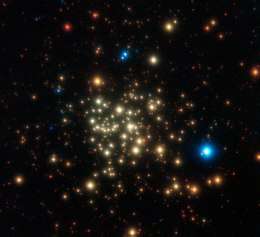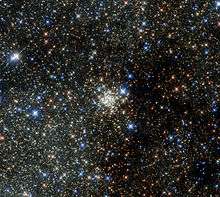Arches Cluster
| Arches Cluster | |
|---|---|
 | |
| Observation data (J2000 epoch) | |
| Constellation | Sagittarius |
| Right ascension | 17h 45m 50.5s |
| Declination | –28° 49′ 28″ |
| Distance | 25 kly (8.5 kpc) |
| Physical characteristics | |
| Notable features | Optically obscured |

The Arches Cluster is the densest known star cluster in the Milky Way located about 100 light years from its center, in the constellation Sagittarius (The Archer), 25,000 light-years from Earth. The discovery of this cluster was reported by Nagata et al. in 1995,[1] and independently by Cotera et al. in 1996.[2] Due to extremely heavy optical extinction by dust in this region, the Arches Cluster is obscured in the visual bands, and is observed in the X-ray, infrared, and radio bands. It contains approximately 135 young, very hot stars that are many times larger and more massive than the Sun, plus many thousands of less massive stars.[3]
This star cluster is estimated to be around two and a half million years old.[3][4] Although larger and denser than the nearby Quintuplet Cluster, it appears to be slightly younger. Only stars earlier and more massive than O5 have evolved away from the main sequence while the Quintuplet Cluster includes a number of hot supergiants as well as a red supergiant and three Luminous Blue Variables.[4]
The most prominent members of the Arches Cluster are hot emission line stars: thirteen Wolf-Rayet stars, all massive hydrogen-rich types; and eight class O hypergiants. One of these is an eclipsing binary with a Wolf-Rayet primary and a class O supergiant secondary. X-ray emission from the cluster suggests that many other members are also in close binary systems with two hot luminous members, but there is little evidence of the evolution of these stars being affected by binary mass exchange. The spectral classes and their properties merge smoothly from the main sequence to normal class O giants and supergiants, to class O hypergiants, to the presumed most evolved Wolf-Rayets. One star is intermediate between WN8-9h and O4-6 Ia+. There are no cooler evolved stars.[4]
Work by Donald Figer, an astronomer at the Rochester Institute of Technology suggests that 150 solar masses (M☉) is the upper limit of stellar mass in the current era of the universe. He used the Hubble Space Telescope to observe about a thousand stars in the Arches cluster and found no stars over that limit despite a statistical expectation that there should be several.[5] However, later research demonstrated a very high sensitivity of the calculated star masses upon the extinction laws used for mass derivation, which can affect the upper mass limit by about 30% using different extinction laws[6] (possibly from 150 M☉ to about 100 M☉).
| B=Blum[7] F=Figer[8] | WR#[9] | Spectral type[4] | Luminosity[10] (L☉) | Temperature[10] (effective, K) | Mass[11] (M☉) | Radius[10] (R☉) |
|---|---|---|---|---|---|---|
| B1 | 102bc | WN8-9h | 891,000 | 31,700 | 50 - 60 | 32 |
| F1 | 102ad | WN8-9h | 2,000,000 | 33,200 | 101 - 119 | 43 |
| F2 | 102aa | WN8-9h O5-6 Ia+ | 1,000,000 | 33,500 | 80[4] 60[4] | |
| F3 | 102bb | WN8-9h | 1,260,000 | 29,600 | 52 - 63 | 43 |
| F4 | 102al | WN7-8h | 2,000,000 | 36,800 | 66 - 76 | 35 |
| F5 | 102ai | WN8-9h | 891,000 | 32,100 | 31 - 36 | 31 |
| F6 | 102ah | WN8-9h | 2,240,000 | 33,900 | 101 - 119 | 44 |
| F7 | 102aj | WN8-9h | 2,000,000 | 32,900 | 86 - 102 | 44 |
| F8 | 102ag | WN8-9h | 1,260,000 | 32,900 | 43 - 51 | 35 |
| F9 | 102ae | WN8-9h | 2,240,000 | 36,600 | 111 - 131 | 38 |
| F10 | 102ab | O7-8 Ia+ | 891,000 | 32,200 | 55 - 69 | 24 |
| F12 | 102af | WN7-8h | 1,580,000 | 36,900 | 70 - 82 | 31 |
| F13 | O7-8 Ia+ | |||||
| F14 | 102ba | WN8-9h | 1,000,000 | 34,500 | 54 - 65 | 28 |
| F15 | O6-7 Ia+ | 1,410,000 | 35,600 | 80 - 97 | 32 | |
| F16 | 102ak | WN8-9h | 794,000 | 32,200 | 46 - 56 | 29 |
| F17 | 102ac | O5-6 Ia+ | ||||
| F18 | O4-5 Ia+ | 1,120,000 | 36,900 | 67 - 82 | 26 | |
| F20 | O4-5 Ia | 794,000 | 38,200 | 47 - 57 | 21 | |
| F27 | O4-5 Ia+ | |||||
| F28 | O4-6I | 891,000 | 39,600 | 57 - 72 | 23 | |
| F40 | O4-5 Ia+ | 562,000 | 39,500 | 57 - 72 | 16.1 |
References
- ↑ Nagata, T.; Woodward, C.; Shure, M.; Kobayashi, N. (April 1995). "Object 17: Another cluster of emission-line stars near the Galactic center". Astronomical Journal. 109 (4): 1676. Bibcode:1995AJ....109.1676N. doi:10.1086/117395.
- ↑ Cotera, A.; Erickson, E.; Colgan, S.; Simpson, J.; Allen, D.; Burton, M. (April 1996). "The discovery of hot stars near the Galactic center thermal radio filaments". Astrophysical Journal. 461 (750): 750. Bibcode:1996ApJ...461..750C. doi:10.1086/177099.
- 1 2 Espinoza, P.; Selman, F. J.; Melnick, J. (July 2009). "The massive star initial mass function of the Arches cluster". Astronomy and Astrophysics. 504 (2): 563–583. arXiv:0903.2222. Bibcode:2009A&A...501..563E. doi:10.1051/0004-6361/20078597.
- 1 2 3 4 5 6 Clark, J. S; Lohr, M. E; Najarro, F; Dong, H; Martins, F (2018). "The Arches cluster revisited: I. Data presentation and stellar census". arXiv:1803.09567 [astro-ph.SR].
- ↑ Figer, Donald F. (2005). "An upper limit to the masses of stars". Nature. 434 (7030): 192–194. arXiv:astro-ph/0503193. Bibcode:2005Natur.434..192F. doi:10.1038/nature03293. ISSN 0028-0836. PMID 15758993.
- ↑ Habibi, M.; Stolte, A.; Brandner, W.; Hußmann, B.; Motohara, K. (August 2013). "The Arches cluster out to its tidal radius: dynamical mass segregation and the effect of the extinction law on the stellar mass function". Astronomy and Astrophysics. 556 (A26): A26. arXiv:1212.3355. Bibcode:2013A&A...556A..26H. doi:10.1051/0004-6361/201220556.
- ↑ Blum, R. D.; Schaerer, D.; Pasquali, A.; Heydari-Malayeri, M.; Conti, P. S.; Schmutz, W. (2001). "2 Micron Narrowband Adaptive Optics Imaging in the Arches Cluster". The Astronomical Journal. 122 (4): 1875. arXiv:astro-ph/0106496. Bibcode:2001AJ....122.1875B. doi:10.1086/323096.
- ↑ Figer, D. F.; Najarro, F.; Gilmore, D.; Morris, M.; Kim, S. S.; Serabyn, E.; McLean, I. S.; Gilbert, A. M.; Graham, J. R.; Larkin, J. E.; Levenson, N. A.; Teplitz, H. I. (2002). "Massive Stars in the Arches Cluster". The Astrophysical Journal. 581: 258. arXiv:astro-ph/0208145. Bibcode:2002ApJ...581..258F. doi:10.1086/344154.
- ↑ Van Der Hucht, K. A. (2006). "New Galactic Wolf-Rayet stars, and candidates. An annex to the VIIth Catalogue of Galactic Wolf-Rayet Stars". Astronomy and Astrophysics. 458 (2): 453. arXiv:astro-ph/0609008. Bibcode:2006A&A...458..453V. doi:10.1051/0004-6361:20065819.
- 1 2 3 Martins, F.; Hillier, D. J.; Paumard, T.; Eisenhauer, F.; Ott, T.; Genzel, R. (2008). "The most massive stars in the Arches cluster". Astronomy and Astrophysics. 478: 219. arXiv:0711.0657. Bibcode:2008A&A...478..219M. doi:10.1051/0004-6361:20078469.
- ↑ Gräfener, G.; Vink, J. S.; de Koter, A.; Langer, N. (2011). "The Eddington factor as the key to understand the winds of the most massive stars". Astronomy & Astrophysics. 535: A56. arXiv:1106.5361. Bibcode:2011A&A...535A..56G. doi:10.1051/0004-6361/201116701. ISSN 0004-6361.
External links
- The Arches Cluster — ESO Image Gallery
- "HubbleSite - NewsCenter - Hubble Spies Giant Star Clusters Near Galactic Center (09/16/1999) - Release Text". hubblesite.org.
- "Chandra :: Photo Album :: The Arches Cluster :: 06 Jun 01". chandra.harvard.edu.
- "Hubble Arches Star Cluster Photo". www.spaceimages.com.